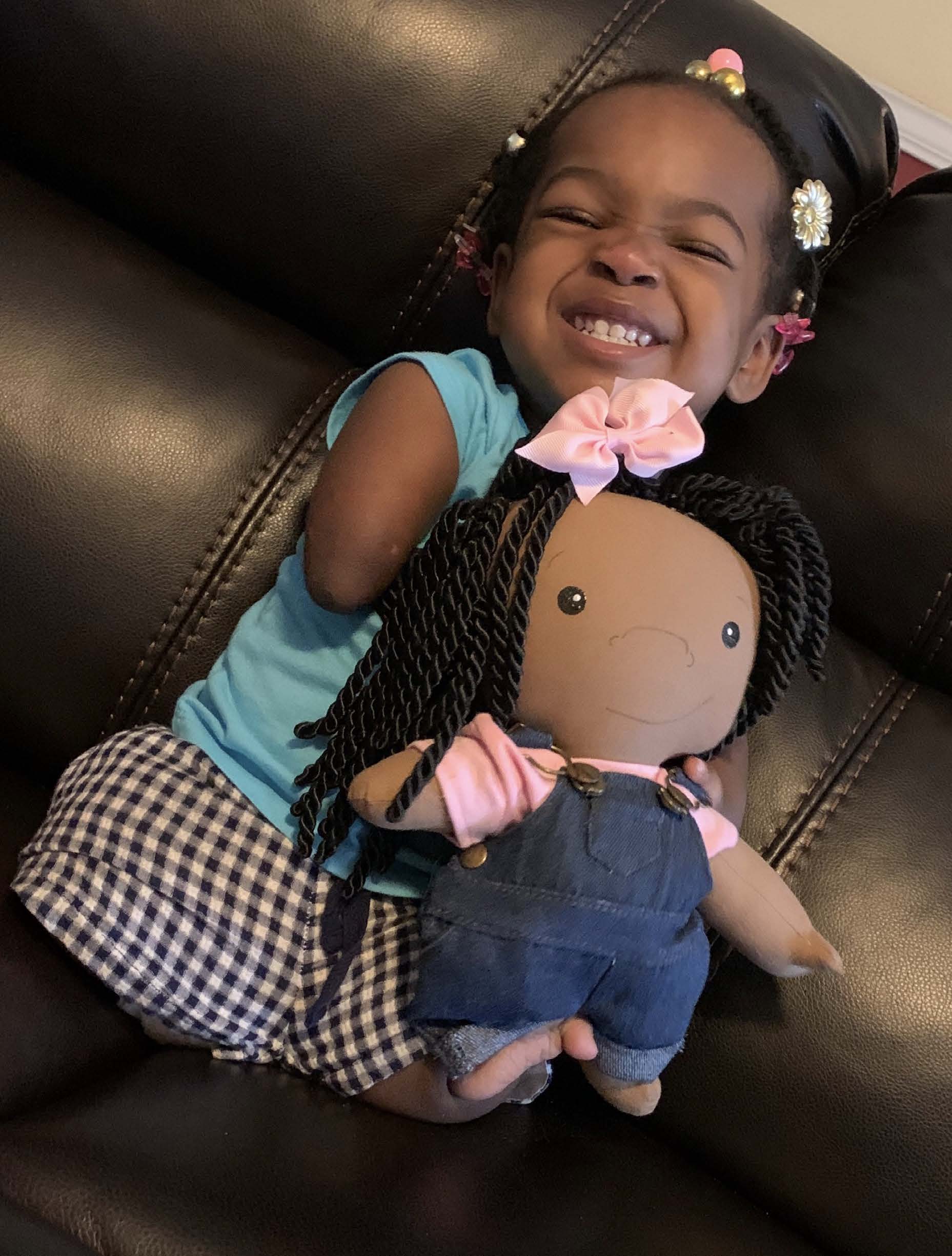
REPRESENTATION MATTERS : Ryann and her Doll Like Me; "Children need to see THEIR faces in the dolls that they play with."
A DOLL like me
BY AMY JANDRISEVITS
Let me tell you a little bit about what I do. I pretty much have my childhood dream job. I am a doll maker. I sew dolls… but not just any dolls. I make dolls for kids who are never afforded the privilege of seeing themselves on the store shelves. My work is magical. I get to see the beauty in children that the people who love them see… and then I capture it in the sweet face of a doll.
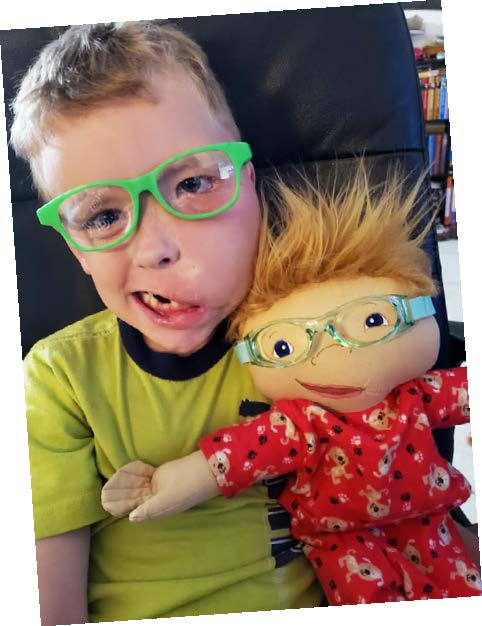
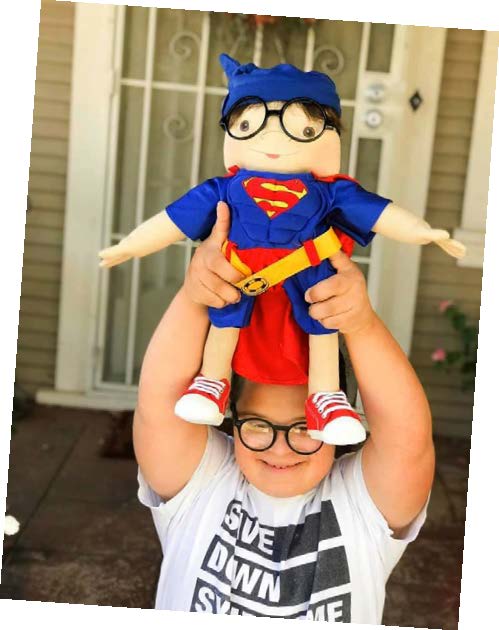
FAMILIAR FACES: Zachariah (top) and Micah (below) show that being unique is beautiful. "Physical and medical differences are even rare for dolls, even though millions of children have them!"
The kids I sew for aren't the ones you'd see on the store shelves. "My kids" have limb differences and hand differences; albinism; scars from fires; birthmarks; cancer; medical equipment ranging from cochlear implants to feeding tubes; facial anomalies. Let's be honest… when was the last time you walked into a toy aisle and saw a doll with one of those options? I'm going with never. In fact, these kids rarely see a likeness of themselves anywhere. I find it a bit ironic that the hashtags "representation" and "inclusion" log well over a million posts on social media… yet WHO we see in major industries and HOW we see them remains relatively homogeneous.
We tend to minimize the importance of "seeing yourself" and being represented. We tend to downplay how this lack of representation plays out in a child's life – particularly in one of the most powerful industries in the world. The toy industry! This is a billion dollar industry and it is incredibly rare to see dolls that look like the children who love them. If we want to teach kids that beauty comes in all colors, shapes, sizes and forms, let's start with toys. Interestingly enough, my Master's thesis was on the healing power of play. To understand the sometimes-fragile psyches of children and nurture their minds, we have to speak their language.
Play IS the language of children. Psychologists agree that dolls are a critical part of therapy with children; and most would also agree that children need to see THEIR faces in the dolls that they play with. We cannot ask a child of color to pretend that the blonde, blue eyed doll on their lap is them… because it's not. Yet, this happens all the time. Physical and medical differences are even more rare for dolls, even though millions of children have them! If we are going to become a community that believes in the health of the whole child, we have to decide that mental and emo tional health are of equal importance to medical care. Before staying home with my own kids, I was a pediatric oncology social worker, and I can tell you how important dolls are for a variety of reasons. Play in a hospital setting is so interesting because you simultaneously want to empower the child in a seemingly out-of-control situation; educate them about what's happening; ease their fears; and provide comfort. Dolls are perfect for this job. We do children a disservice when we don't give them the basic courtesy of something that looks like they do.
My goal is simple. I want to provide children with a doll that looks like they do and I want them to see that being unique IS beautiful. I want them to experience the power in representation. Understand that WHO we see and HOW we see them matter to the millions of kids that don't look like most of the images that they are bombarded with on a daily basis. Some of the older kids I've made dolls for will tell you that they never imagined how powerful it would be to see themselves in a human likeness. Because really… don't we all want to be seen? And not only that, don't we all want to experience the power of inclusion?
I talk a lot about changing the narrative. I am fortunate that dolls have given me a platform where I can do this. Parents often tell me how the comments in public have shifted from "What's wrong with him" or "Why does she look like that?" to "How cute that the doll is a miniature version of him!" That's an entirely different message, isn't it? Imagine what that sounds like to the child.
A year and a half ago, a journalist wrote an article that was titled "Mom makes dolls for girls suffering from selfesteem issues at her dining room table" and I was appalled – for many reasons. I called the editor before it went to print and said as much. He said, "What do you WANT the headline to read?" to which I answered, "What do you want the story to be about? Is it about a mom who makes dolls? Or is it about kids who, for the first time in their lives, are seeing themselves in a human likeness?" He wanted the story to be about the mom – me sewing at my dining room table.
I said, "That's too bad because you have the opportunity to change the narrative for so many kids." I believe that the media has a chance to change the literal narrative and it's so powerful because it gives a voice to the people who don't have one. He laughed and said, "Do you really think your dolls have the power to do that?" I said, "My dolls don't, but your words do."
That's what I mean about changing the narrative. I tell every young journalist and writer that does a story on these dolls to tell it like it will go viral… because what if it does? Tell the story like these kids are depending on you… because they are. You are advocating for a paradigm shift and you can do so simply by the words you choose. I imagine that many of us have fallen into the role of "advocate" simply by what we are passionate about and what we have learned along the way. The conversation with that editor brought to mind the saying – if not me, then who?
About a year and a half ago, A Doll Like Me, Inc. became a 501c3, nonprofit organization and it is one of my proudest accomplishments. This is how these dolls will make their way into the waiting arms (and legs!) of kids who don't know what "representation" means, but know what it feels like. Most notably, the nonprofit offsets the cost so that the dolls are a gift on behalf of our global community to kids who so desperately need them – kids who so desperately need to see themselves. I send dolls from as local as Milwaukee to as far away as Egypt and Columbia and Australia. Part of my role as a doll maker has evolved into "talking" about them, because it's how we change the narrative. I talk a lot about representing children of all abilities in one of the places where it matters most – the toy market. And if I'm honest, it is such a thrill to be able to talk about something that meant so much to ME as a child… dolls! The photos of the kids with their dolls have grabbed people's attention because they're pretty remarkable. The dolls have since appeared in Oprah Magazine, in People Magazine, on WebMD, on CBS Evening News, and in toy, business, and entrepreneur magazines. I believe that we cannot understand the urgency of representation until we look into the face of these children… watch their reactions… and hear what they say about feeling validated. Often times I hear from adults who will say, "Having a doll that looked like me could have been a game changer" or "I struggled my whole life with how I looked and I would have loved to have a doll that looks like me." I even have video of some of the really little guys whose faces light up when they realize that the doll they are holding is them!
One doll, made for a friend of a friend, turned into another and another… and suddenly I was looking at trademarks and lawyers and a wait list hundreds of dolls deep. That's how I know that we are hungry for a shift… we want "representation matters" to be more than a hashtag on social media. I want people to understand how a simple act can be a catalyst for change… how a doll can ignite a global conversation on what it means to be seen. Later this month, my dolls will be a case study in a book from Google about production inclusion. I am over the moon with excitement – not because I'm hoping for doll orders. Rather, this is how the paradigm shifts.
I work at my dining room table and my kitchen counter doubles as a work station. We haven't eaten at our dining room table in over three years! As I type this, my husband is reading at the kitchen table – where the doll next to him is waiting for finishing touches. My glue gun sits on the counter so that I can do one more thing before I go to bed. My family understands that this is important to me and when you have a "calling," for lack of a better word, you go with it. I do this because I need to.
I believe that we are ready for a new narrative. Scratch that. We aren't just ready for a new narrative… we are hungry for one. This new narrative includes everyone and gives everyone (yes, everyone) a place at the table. One of the things that I tell my doll audience is that we are consumers. Demand change. Tell people what you want to see and support the companies that are part of the paradigm shift.
As for me, I like to say that the 10-year-old version of Amy is THRILLED that I still get to play with dolls many years later. I love being able to combine my passion for social work with creativity. It is a privilege and an honor to be invited into lives filled with beauty, tragedy, joy, pain, pride, and raw emotion. I get to provide dolls for those at the beginning of their lives and for those who sometimes are at the end. And sometimes this human likeness of a child is a part of the grieving process because it is a physical representation of those sweet babies whose lives are cut short. I am humbled and thrilled by the response I have received. Helping to change this narrative about WHO we see and HOW we see them is the least I can do.
Remember… that which makes us different also makes us beautiful and because of that, everyone deserves to see themselves in the places that matter. Start talking. It's ultimately your words that will change the narrative.•
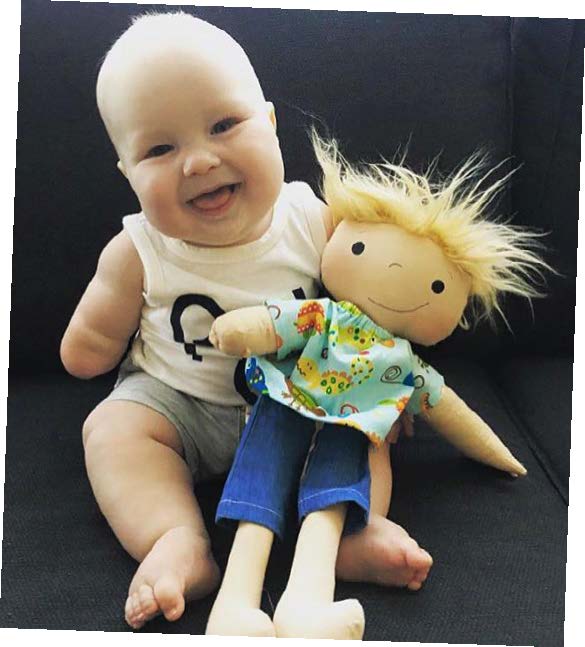
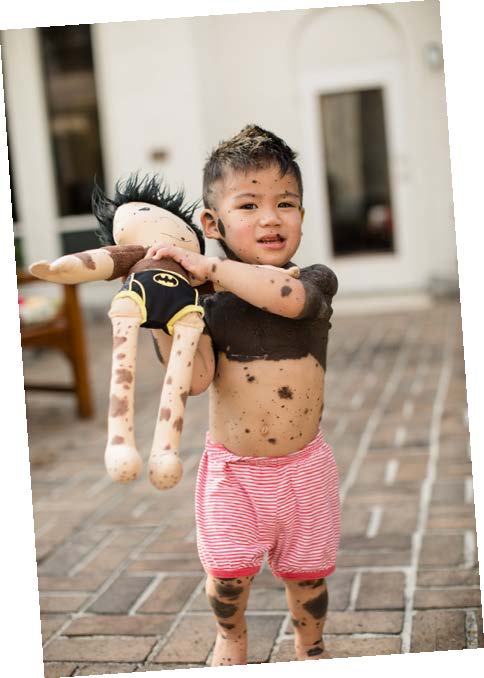
SEE FOR YOURSELF: Bennett (top) and Keagan (below) share their special features with their dolls. "This new narrative includes everyone and gives everyone (yes, everyone) a place at the table."
ABOUT THE AUTHOR: Amy Jandrisevits is the founder of A Doll Like Me, Inc. adolllikeme.com GoFundMe: adolllike.me